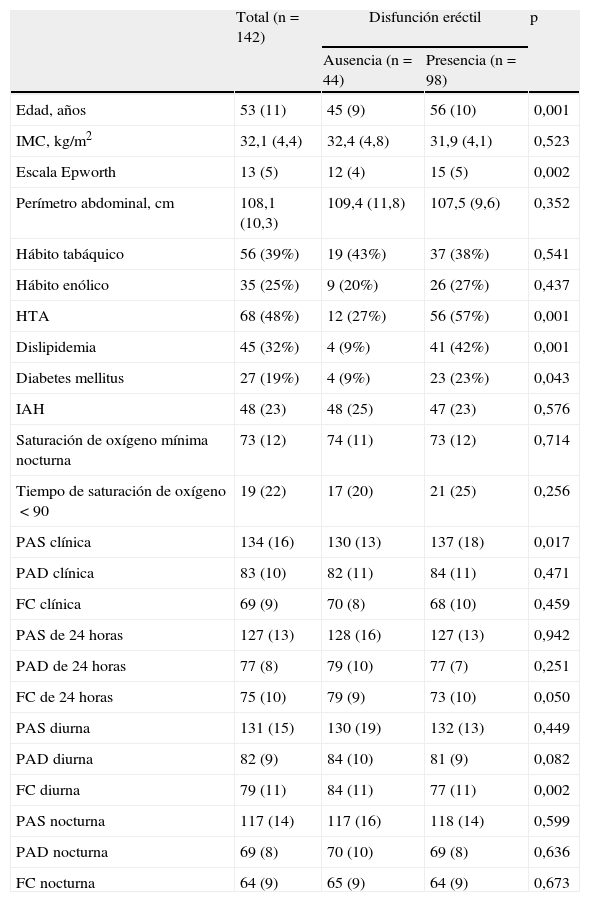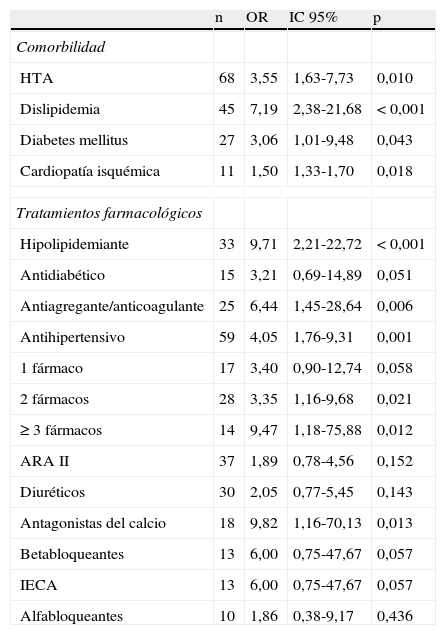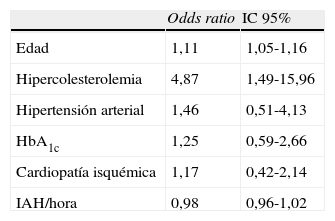El síndrome de apnea obstructiva del sueño (SAOS) puede contribuir al desarrollo de disfunción eréctil (DE) a través de múltiples mecanismos. El objetivo fue identificar los factores que están relacionados con la presencia de DE en estos pacientes.
Pacientes y métodoEstudio transversal en varones diagnosticados de SAOS. Se recogieron variables demográficas, índice de apneas-hipopneas (IAH), comorbilidad, fármacos, presión arterial, escala Epworth, exploración física, electrocardiograma, índice tobillo-brazo, analítica sanguínea y de orina. La presencia de DE se valoró mediante el cuestionario IIEF-5.
ResultadosSe incluyeron 142 pacientes, con una edad media (desviación estándar) de 53 (11) años. La prevalencia de DE fue del 69%. Encontramos diferencias significativas en el IAH entre los pacientes con DE leve y grave (41 [21] frente a 63 [18]; p=0,023). La DE se asoció a la hipertensión arterial [HTA] (odds ratio [OR] 3,56; intervalo de confianza del 95% [IC 95%] 1,64-7,72), hipercolesterolemia (OR 7,19; IC 95% 2,39-21,68), diabetes mellitus tipo 2 (OR 3,07; IC 95% 1,02-9,48) y cardiopatía isquémica (OR 1,51; IC 95% 1,33-1,70), así como al tratamiento con antihipertensivos (OR 4,05; IC 95% 1,76-9,31), hipolipidemiantes (OR 9,71; IC 95% 2,21-22,72), antidiabéticos (OR 3,21; IC 95% 0,69-14,89), antiagregantes y anticoagulantes (OR 6,44; IC 95% 1,45-28,64). Tras el análisis de regresión logística, la DE se asoció con la edad (OR 1,11; IC 95% 1,05-1,16) y la hipercolesterolemia (OR 4,87; IC 95% 1,49-15,96).
ConclusionesLos pacientes con SAOS tienen una alta prevalencia de DE, principalmente en SAOS grave. Los factores que influyen en la presencia de la DE en pacientes con SAOS son fundamentalmente la edad y la hipercolesterolemia. Otros factores que pueden estar relacionados son la HTA, el mal control metabólico, la cardiopatía isquémica y el consumo de antihipertensivos, estatinas y antidiabéticos.
Obstructive sleep apnea (OSA) syndrome can contribute to the development of erectile dysfunction (ED) through multiple mechanisms. The aim was to identify factors influencing the presence of ED in these patients.
Patients and methodsCross sectional study in men diagnosed with OSA by polysomnography. We obtained information about demographic variables, apnea-hypopnea index (AHI), comorbidity, blood pressure, drugs, Epworth Sleepiness Scale, physical examination, electrocardiogram, ankle-brachial index and blood and urine analysis. The presence of ED was assessed by questionnaire IIEF-5.
ResultsWe included 142 patients, mean age was 53 (11) years. The prevalence of ED was 69%. We found significant differences in AHI between patients with mild and severe ED (41 [21] vs 63 [18], P=.023). ED was associated with hypertension (odds ratio [OR]=3.56 [1.64-7.72]), hypercholesterolemia (OR=7.19 [2.39-21.68]), diabetes mellitus type 2 (OR=3.07 [1.02-9.48]) and ischemic heart disease (OR=1.51 [1.33-1.70]); and treatment with antihypertensive (OR=4.05 [1.76-9.31)], lipid-lowering drugs (OR=9.71 [2.2-22.72]), anti-diabetic drugs (OR=3.21 [0.69-14.89]), antiplatelet and anticoagulant agents (OR=6.44 [1.45-28.64]). After logistic regression analysis, only age (OR=1.11 [1.05-1.16]) and hypercholesterolemia (OR=4.87 [1.49-15.96]) were associated with ED.
ConclusionsPatients with OSA have a high prevalence of ED, mainly in severe OSA. Factors influencing the presence of ED in patients with OSA are primarily age and hypercholesterolemia. Other factors that may be related include hypertension, poor metabolic control, ischemic heart disease, and treatment with antihypertensive, lipid-lowering and anti-diabetic drugs.
Artículo
Comprando el artículo el PDF del mismo podrá ser descargado
Precio 19,34 €
Comprar ahora










